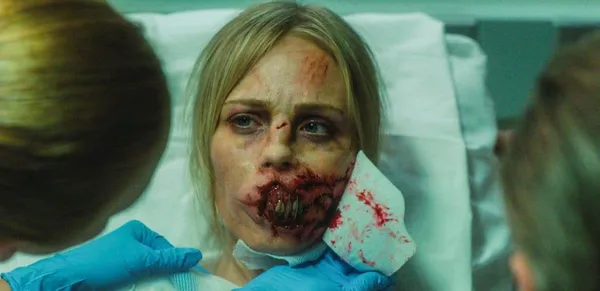 |
| The Soska sisters' Rabid Photo: FrightFest |
Back in 1977, David Cronenberg was a little-known filmmaker working on a tiny budget with very little support. His tale of reconstructive surgery and rapidly spreading contagion, Rabid, took the industry by surprise and helped to launch a career that would turn him into a filmmaking legend. This year the Soska sisters, Sylvia and Jen, are launching their remake of the film at Frightfest. Two highly talented filmmakers who deserve a lot more attention from the mainstream, they’re in a similar position to the one Cronenberg was in back then, and their Rabid, itself a standout piece of work, might be the film that gets them there. I was delighted to have the opportunity to talk to them about it and began by asking if they have been longstanding Cronenberg fans.
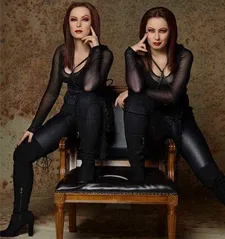 |
| The Soska sisters Photo: FrightFest |
Sylvia – “You know, when I was a young girl I wasn’t allowed to watch Cronenberg films. I had to sneak Shivers. I had to sneak Crash. It wasn’t until I was more of an adult as a teenager that I realised ‘oh my gosh, that’s the same filmmaker!’ And it wasn’t that our family wouldn’t let us watch horror movies – we watched all sorts of gore and Stephen King and stuff with my mom. We have a very Catholic family, Jennifer and I, we were two of the first female altar servers for the Roman Catholic Church. So they were very firm on no sexual violence, which is something that David always explores, the sexuality, and he takes taboo and kind of turns it on its head, and I understand why parents could be lick ‘Oh, these are weird ideas!’, you know?”
“I wouldn’t say I started as a Cronenberg fan,” says Jen. “The first film that I remember seeing clearly was The Fly. I was destined to be a hardcore fan but that movie scarred me. it was one of those movies that you just can’t throw away and it’s not just he subject material, it’s not just the prosthetics, which were masterful, and it wasn’t just the performance. It was how it was such a human story and such a supernatural, bizarre setting, about two people who meet each other, beyond all odds they fall in love, and then they don’t get to spend the rest of their lives happily ever after. A powerful film!
“After I got through the shock value of that film,” she laughs, “I became a huge Cronenberg fan. I think the next one I saw was Videodrome and then I saw The Brood and then I saw Shivers.”
“I saw Shivers without Jen,” explains Sylvia. “I felt like a bad twin but you know, if there was a good movie on and nobody was watching you, you had to take that opportunity.”
“Every Cronenberg movie is kind of weird,” says Jen. “You can’t watch it just once and understand it. They’re very rewatchable.”
So what persuaded the two of them that they wanted to take on a remake of Rabid?
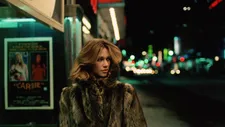 |
| David Cronenberg's Rabid |
“I actually hated the idea of somebody taking on this remake that didn’t have a love or an appreciation or understanding of David’s work,” says Jen. “When a remake comes out the original creator’s name is thrown around and then people say stupid things like ‘Oh, which one was better?’ The original was the best one or you wouldn’t be remaking it.”
“We got a random email one December saying ‘Hey, would you guys like to remake a Cronenberg movie?’” says Sylvia. “When we told our representation about that they were like ‘Please don’t respond to that. That’s not a real movie.’ But I’m so glad we did because it absolutely was. We’ve been directing for the last 13 years but we’ve been acting since we were seven years old – we’re 36 six now – and identical twins in the entertainment business, it hasn’t had positive connotations since the negative attention the Olsen twins got when they were on Full House, and it was somewhat normalised, the negative attention that would be put on twins. So it had got to a point where I didn’t know why were still making these movies, especially in this kind of environment, and then this opportunity came and the more I heard about it...
“When we spoke to the producers, they got the script and they didn’t really know who Cronenberg was, and they googled his name and we popped up. And so they asked us to explain Cronenberg and the conversation ended with ‘You handle everything creatively and we’ll handle everything with money,’ which was the first time we ever got that opportunity, and if you want to tackle something like a Cronenberg movie, being the first ones to do it, you really need your creativity to be free.”
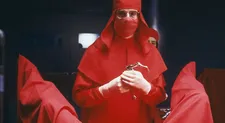 |
| Dead Ringers |
“We really lucked out with being offered Rabid,” says Jen, “because it’s not really considered one of his holy grail films. I mean, all his films are brilliant but I wouldn’t eve name Rabid as one of my top five favourites – not because it isn’t a brilliant film, it’s just that I love so many of his pieces. I really wanted people to appreciate David and I wanted people, if they hadn’t been familiar with his body of work, to be introduced to him in the absolute best way. The best thing for me is if somebody watches this film and thinks ‘Wow, this is great,’ and then they look at David’s films and they just have to own the stuff he did.”
There are a lot of apparent references to Cronenberg’s other films in their remake. How deliberate was that?
“That was absolutely intentional,” says Sylvia. “We had our costumer, Morganne Newson, import the red Egyptian silk to make exact replicas of the Dead Ringers surgery scene. You might not notice but with Dr Burroughs, played by Ted Atherton, across from him is Dr Eliot, who’s played by Heidi von Palleske, who’s actually one of the stars of dead Ringers. So we made sure we had cast and crew who’d worked with David because as much as we were ready and up to the task we wanted to have people who were brilliant around us so we could go ‘Ach! What would David do?’”
“We really wanted to give an homage to all of his films,” says Jen. “The Dead Ringers one is a very striking, obvious one because it’s obviously my favourite Cronenberg film of all time. I’d love to take it and turn into into a television series because those characters and that story is too good for just a film. There are references to all all of his films, some more subtle, and even to his novel. The most disturbing Easter egg is to The Brood.” Where it is has to be a secret, she says, until people see the film.
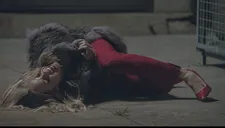 |
| Rabid 2019 Photo: FrightFest |
“There’s also quite a few homages to other films we love,” she continues, “like [film id= 9239]Irreversible[/film] or In The Mouth Of Madness – and of course American Mary. We thought it would be cheeky of us to pay a little tribute to our original.”
“There’s a lot of Spider-Man 2 in there and it almost starts the exact same way,” says Sylvia. “She’s looking at a billboard, it’s not Mary Jane it’s Chelsea it’s kind of the same.”
“Oh yeah, and we also took from Invisible Monsters, the Chuck Palahniuk novel,” adds Jen. “He’s the writer of Fight Club but his novels are just so masterful and I think people that like the film would really love his books. Invisible Monsters is all over the film but I don’t think people read as much as they should so they’re going to think it’s very new and very novel but it’s not, it’s also a tribute.”
Given the issues they explored in American Mary, is plastic surgery a subject of ongoing interest to them?
Sylvia responds first. “I think because we’re identical twins our physical form is so prioritised in everything, so Jennifer and I find it very interesting when people want to change that physical form – not necessarily in cosmetic surgery because I find a lot of the time they’re trying to fix something in their relationship with themselves or their relationship with somebody else. I have a friend who’s called Burns the Dragon and he’s a human transitioning into a dragon. His eyes are purple, his tongue is forked, he has 3D implants, he’s got tattoos all over his body, he’s got scarification going on, and we’ve been friends for years but it shocked me that he is ostracised from society whereas I can hang out with some of my friends that have very acceptable cosmetic surgery and everyone’s like ‘Oh, she’s so hot but that other guy’s so scary.’
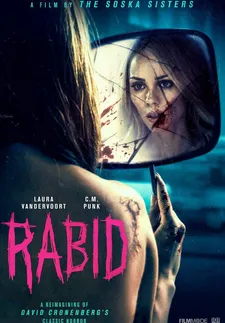 |
| Rabid poster |
“I think there is taboo in what we appreciate for beauty. I think gorgeousness is over-appreciated. I think something like wabi-sabi, which is the number one aesthetic in Japan, where you appreciate things that are genuine, things that are real, maybe things that aren’t as pretty, is really important, especially in the world that we live in.”
“I totally encourage people in their own forms of self expression,” says Jen. “What I prefer in the body modification community, compared to cosmetic surgery – so much of cosmetic surgery has become what is the overall idea of what is beautiful. How do I look beautiful in someone else’s standards? I mean, in Los Angeles every woman basically looks the exact same. I myself might not be perfect-looking but if you think about all the generations and all the people who had to survive and find each other and fall in love and raise a child and then another child and then another child – I might have flaws but they’re all badges of honour from all of my ancestors.
“I think if we looked at people a little bit more realistically we’d take from that a bit more reality... I think if people realised that being ‘ugly’ is part of the human condition they would be a lot happier. I do love the manipulation of the flesh but I do love to create the conversation of ‘Why are you doing this?’”
“And so much of this is in the original Rabid,” adds Sylvia. “I mean, he pre-dated stem cell research, he anticipated all of these trends. He was actually taking a lot about transhumanism and for somebody as vastly intelligent as him we had to make sure that we took this very real school of thought that’s doing monstrous things around the world – just recently we saw a hybrid of a rat human from China – or was that Japan? And then I think China had a human-sheep hybrid, and nobody’s saying anything. What happen when we start playing God and we throw ethics and morality out of the window? We start going into a very Cronenbergian atmosphere where anything can happen.”
“Yeah,” says Jen. “David was predicting all that stuff. He also made one of the very first plastic surgery jokes in Rabid. A girl’s coming in saying ‘Daddy bought be a new nose because he didn’t like the last one,’ and back in 1977 that would have been like an obscene comment. Now it’s so normalised. Teenagers are having nose-jobs for the sweet sixteenth. It’s insane. Their bodies haven’t even finished growing.”
Coming up: the Soska sisters on how the experience of growing up female influenced their take on Rabid, and why they love being back at Frightfest.
Rabid premières at Frighfest on Monday 26 August.





















